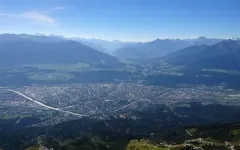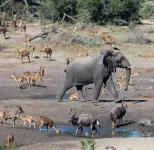(Press-News.org) Since they are far more compact than today's accelerators, which can be kilometers long, plasma accelerators are considered as a promising technology for the future. An international research group has now made significant progress in the further development of this approach: With two complementary experiments at the Helmholtz-Zentrum Dresden-Rossendorf (HZDR) and at the Ludwig-Maximilians-Universität Munich (LMU), the team was able to combine two different plasma technologies for the first time and build a novel hybrid accelerator. The concept could advance accelerator development and, in the long term, become the basis of highly brilliant X-ray sources for research and medicine, as the experts describe in the journal Nature Communications (DOI: 10.1038/s41467-021-23000-7).
In conventional particle accelerators, strong radio waves are guided into specially shaped metal tubes called resonators. The particles to be accelerated - which are often electrons - can ride these radio waves like surfers ride an ocean wave. But the potential of the technology is limited: Feeding too much radio wave power into the resonators creates a risk of electrical charges that can damage the component. This means that in order to bring particles to high energy levels, many resonators have to be connected in series, which makes today's accelerators in many cases kilometers long.
That is why experts are eagerly working on an alternative: plasma acceleration. In principle, short and extremely powerful laser flashes fire into a plasma - an ionized state of matter consisting of negatively charged electrons and positively charged atomic cores. In this plasma, the laser pulse generates a strong alternating electric field, similar to the wake of a ship, which can accelerate electrons enormously over a very short distance. In theory, this means facilities can be built far more compact, shrinking an accelerator that is a hundred meters long today down to just a few meters. "This miniaturization is what makes the concept so attractive," explains Arie Irman, a researcher at the HZDR Institute of Radiation Physics. "And we hope it will allow even small university laboratories to afford a powerful accelerator in the future."
But there is yet another variant of plasma acceleration where the plasma is driven by near-light-speed electron bunches instead of powerful laser flashes. This method offers two advantages over laser-driven plasma acceleration: "In principle, it should be possible to achieve higher particle energies, and the accelerated electron beams should be easier to control," explains HZDR physicist and primary author Thomas Kurz. "The drawback is that at the moment, we rely on large conventional accelerators to produce the electron bunches that are needed to drive the plasma." FLASH at DESY in Hamburg, for instance, where such experiments take place, measures a good one hundred meters.
High-energy combination
This is precisely where the new project comes in. "We asked ourselves whether we could build a far more compact accelerator to drive the plasma wave," says Thomas Heinemann of the University of Strathclyde in Scotland, who is also a primary author of the study. "Our idea was to replace this conventional facility with a laser-driven plasma accelerator." To test the concept, the team designed a sophisticated experimental setup in which strong light flashes from HZDR's laser facility DRACO hit a gas jet of helium and nitrogen, generating a bundled, fast electron beam via a plasma wave. This electron beam passes through a metal foil into the next segment, with the foil reflecting back the laser flashes.
In this next segment, the incoming electron beam encounters another gas, this time a mixture of hydrogen and helium, in which it can generate a new, second plasma wave, setting other electrons into turbo mode over a span of just a few millimeters - out shoots a high-energy particle beam. "In the process, we pre-ionize the plasma with an additional, weaker laser pulse," Heinemann explains. "This makes the plasma acceleration with the driver beam far more effective."
Turbo ignition: Almost to the speed of light within just one millimeter
The result: "Our hybrid accelerator measures less than a centimeter," Kurz explains. "The beam-driven accelerator section uses just one millimeter of it to bring the electrons to nearly the speed of light." Realistic simulations of the process show a remarkable gradient of the accelerating voltage in the process, corresponding to an increase of more than a thousand times when compared to a conventional accelerator. To underscore the significance of their findings, the researchers implemented this concept in a similar form at the ATLAS laser at LMU in Munich. However, the experts still have many challenges to overcome before this new technology can be used for applications.
In any case, the experts already have possible fields of application in mind: "Research groups that currently don't have a suitable particle accelerator might be able to use and further develop this technology," Arie Irman hopes. "And secondly, our hybrid accelerator could be the basis for what is called a free-electron laser." Such FELs are considered extremely high-quality radiation sources, especially X-rays, for ultra-precise analyses of nanomaterials, biomolecules, or geological samples. Until now, these X-ray lasers required long and expensive conventional accelerators. The new plasma technology could make them much more compact and cost-effective - and perhaps also affordable for a regular university laboratory.
INFORMATION:
Publication:
T. Kurz, T. Heinemann, M. F. Gilljohann, Y. Y. Chang, J. P. Couperus Cabada?, A. Debus, O. Kononenko, R. Pausch, S. Schöbel, R. W. Assmann, M. Bussmann, H. Ding, J. Götzfried, A. Köhler, G. Raj, S. Schindler, K. Steiniger, O. Zarini, S. Corde, A. Döpp, B. Hidding, S. Karsch, U. Schramm, A. Martinez de la Ossa, A. Irman: Demonstration of a compact plasma accelerator powered by laser-accelerated electron beams, in Nature Communications, 2021 (DOI: 10.1038/s41467-021-23000-7)
For more information, contact:
Dr. Arie Irman
Institute of Radiation Physics
Phone: +49 351 260-3043 | email: a.irman@hzdr.de
Media contact:
Simon Schmitt | Head
Communications and Media Relations at HZDR
Phone: +49 351 260 3400 | Email: s.schmitt@hzdr.de
The Helmholtz-Zentrum Dresden-Rossendorf (HZDR) performs - as an independent German research center - research in the fields of energy, health, and matter. We focus on answering the following questions:
* How can energy and resources be utilized in an efficient, safe, and sustainable way?
* How can malignant tumors be more precisely visualized, characterized, and more effectively treated?
* How do matter and materials behave under the influence of strong fields and in smallest dimensions?
To help answer these research questions, HZDR operates large-scale facilities, which are also used by visiting researchers: the Ion Beam Center, the High-Magnetic Field Laboratory Dresden, and the ELBE Center for High-Power Radiation Sources.
HZDR is a member of the Helmholtz Association and has six sites (Dresden, Freiberg, Grenoble, Görlitz, Leipzig, Schenefeld near Hamburg) with almost 1,200 members of staff, of whom about 500 are scientists, including 170 Ph.D. candidates.
An international team, led by researchers from Pompeu Fabra University (UPF) in Barcelona, Spain, David Andreu and Rafael Maldonado, has developed a peptides family that allows delta-9-tetrahydrocannabinol (THC), the main component of Cannabis sativa, to fight pain in mice without side effects. The study, published in the Journal of Medicinal Chemistry, was carried out together with researchers from the Autonomous University of Barcelona, ??the University of Barcelona, and the University of Lisbon.
At present, there are two main types of pain relievers prescribed based on the severity of the pain. Nonsteroidal ...
The high-power and long-pulse operation of tokamak will cause excessive particle flux and heat load on the divertor target plate. The surface of the target plate will be subject to intense sputtering, and the thermal load of the target plate will exceed the material/component limit.
The sputtered atoms generated by the damage of the target plate may be transported to the core plasma, degrading the quality of the fusion plasma and increasing the difficulty of plasma stability control.
Recently, the EAST group of Institute of Plasma Physics, Hefei Institutes of Physical Science (HFIPS), reported their new findings about the influence of different impurity gases ...
"Pretty" parrots are more likely to be snatched up for Indonesia's illegal wildlife trade, a new study reveals.
The findings not only expose the key drivers behind the country's illegal trade in these birds, but offer lessons for the potential emergence and spread of infectious diseases that jump from animals to humans - like COVID-19 and avian flu.
The study, involving researchers from The Australian National University (ANU), analysed two decades worth of data on the illegal trade of parrots in Southeast Asia.
The researchers found some key reasons parrots ...
E-scooters as a new micro-mobility service: SMART researchers explore the potential of e-scooter sharing as a replacement for short-distance transit in Singapore
SMART researchers found that e-scooters are not only a last-mile solution to complement transit services, but also provide a mobility service for short-distance transit trips
- Through a stated preference survey and mixed logit models, SMART researchers found that fare, transit transfer, and transit walking distance are significant factors driving the use of e-scooters as an alternative means of transit. The uncertainty is higher in predicting e-scooter usage preferences of male, young and high-income ...
Tsukuba, Japan - Warm, dry wind events blowing down from mountain slopes, called foehns, are a meteorological phenomenon typically associated with the European Alps or the Rocky Mountains of North America. However, in recent decades, foehn winds in Japan have caused record-breaking hazardous warm weather events, bringing renewed interest in the behavior of these winds in this part of the world.
In a new study published in the International Journal of Climatology, a research team led by the University of Tsukuba has presented the first comprehensive climatological study of Japan's south foehn, a windstorm that originates from the Backbone Mountain Range and is observed along the coast of the Sea of Japan, including in the Toyama ...
Microfluidic chips hold great promise for unparalleled applications in pathogen detection and cancer diagnosis. Such devices often require nanoscale thin films for the filtering of liquid samples, as well as power devices or chemical stimulus that control its flow direction. However, many challenges still remain with most precedent mechanisms, including complicated fabrication processes, limitations of materials, and undesired damage on samples.
A research team, led by Professor Taesung Kim in the Department of Mechanical Engineering at UNIST presented the ...
Everything from the production of fertilisers and plastics, to liquid fuels and pharmaceuticals require an important chemical reaction known as hydrogenation. This is a process involving the addition of hydrogen to unsaturated chemical bonds. Enhancing the rate of hydrogenation can lead to higher yields for industries and lower environmental impacts.
Now, a team of scientists, led by Associate Professor Yan Ning from the Department of Chemical and Biomolecular Engineering at the National University of Singapore (NUS), has come up with a method to increase the rate of ethylene ...
People with Alzheimer's disease (AD) are less likely to have cataract surgery than people without Alzheime's disease. The procedure rate starts to decrease already one year after the diagnosis, according to a new study from the University of Eastern Finland.
The lower likelihood of cataract surgery among people with cognitive disorders has been reported previously. This study is the first to report an association between the AD diagnosis and a lower incidence of cataract surgery, and a decrease in the procedure rate related to the time since the diagnosis.
The decrease in the incidence of cataract surgery among people with newly diagnosed AD is concerning because the benefits of this low-risk procedure would probably be similar for people with and without ...
DALLAS - May 20, 2021 - An experimental drug that has shown promise in protecting healthy tissue from collateral damage caused by radiation therapy for cancer also appears to enhance radiation's capacity to kill tumors, a new study led by UT Southwestern scientists shows. The findings, published online in Science Translational Medicine, could provide a much-needed boost to the radiation treatments used against a variety of tumor types.
The drug, avasopasem manganese (AVA), has already shown promise in clinical trials to prevent a side effect known as acute mucositis. This condition commonly occurs in head and ...
Elephants and lions are iconic species that help raise substantial funds for conservation. However, they also pose significant threats to people, crops, and livestock, and are themselves threatened with extinction.
Areas at severe risk are identified
In a new article published in the journal Nature Communications, scientists have identified the areas that are most at risk for conflicts between humans and elephants and lions in Africa. They also estimated the associated return on investment of building and maintaining high-quality fences, which are used to reduce conflict between humans and wildlife.
Associate Professor Enrico Di Minin, who is the lead author of this article and leads the Helsinki Lab of Interdisciplinary Conservation Science ...









